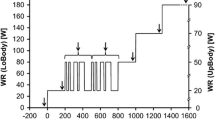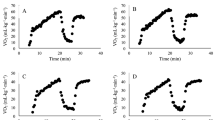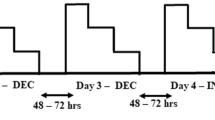Summary
\(\dot V\)O2 max, as obtained by five cycloergometric test protocols, was studied in 14 normal sedentary subjects: seven women (from 21–35 years) and seven men (from 21–48 years) who carried out four (n=14) or five (n=8) of the following exercise programmes: triangular tests, which consist of increasing the load (1) 20 W/min; (2) 30 W/3 min, rectangular tests at constant load; (3) the highest load which the subject could maintain for about 10 min (MSP + 20 W); (4) maximal supported power (MSP) during 20 min; (5) trapezoidal test, consisting of a rectangular exercise of 40 W (10 min), followed test no. 2. Exercises were performed on a cycle ergometer, while \(\dot V\) E , \(\dot V\)O2, \(\dot V\)CO2, f, and fH were continously measured with an open circuit system.
In women, the \(\dot V\)O2 max (\(\bar x\) ± SEM) was lower (36.5±2.1 ml·kg−1·min−1) than in men (48.7±3.6 ml·kg−1·min−1). The highest ventilation rate observed during exercise for the whole group (\(\dot V\) E =101+131·min−1) was always lower than the maximal voluntary ventilation (MVV=144±131·min−1, p<0.001). \(\dot V\)O2 max strongly correlated with lean body weight, VC, FEV1, and MVV.
In spite of the significant differences between the maximal load level sustained with the first three tests, the \(\dot V\)O2 max values were not significantly different. Moreover, there exists an excellent correlation between them. It appears that neither the absolute load sustained in the tests, nor the duration nor intensity of the submaximal load which preceded the maximal level (tests 1, 2, and 5), influence the value of \(\dot V\)O2 max.
Similar content being viewed by others
References
Aide-mémoire pour la pratique de l'examen de la fonction ventilatoire par la spirographie (1971) 2ème edn, vol 1/XI. Commission des Communautés Européennes, Luxembourg
Aide-mémoire pour la pratique des épreuves d'exercice en médecine du travail (1971) Collection Hyg Med Trav no 12. Commission Communautés Européennes, Luxembourg
Astrand PO, Rodahl K (1970) Textbook of work physiology. McGrand, New York, p 669
Carta P, Sanna-Randaccio F, Anni MS, Nissardi GP, Casula D (1979) Modifications respiratoires et métaboliques au cours d'exercices à charge constante à différents niveaux d'intensité par rapport au seuil anaérobique. Bull Eur Physiopath Resp 15: 171–183
Casula D, Nissardi GP, Sanna-Randaccio F, Carta P (1975) Considerazioni sulla interpretazione fisiologica delle prove da sforzo a carico crescente. Boll Soc Ital Biol Sper 51: 1480–1485
Cherchi A, Raffo M, Verzetti G, Maxia L, Fonzo R, Bina M, Olla G (1968) Metabolismo aerobico ed anaerobico ed equilibrio acido-basico nella prova da sforzo triangolare 10 W/min nella bronchopneumopatia cronica ostruttiva. Boll Soc Ital Cardiol 14: 425–434
Davies CTM, Tuxworth W, Young JM (1970) Physiological effects of repeated exercise. Clin Sci 39: 247–258
Davies JA, Vodak P, Wilmor JH, Voda J, Kurtz P (1976) Anaerobic threshold and maximal aerobic power for three modes of exercise. J Appl Physiol 41: 544–550
Durand D, Saunier C (1959) Influence de l'âge, du sexe, des volumes pulmonaires, de la morphologie, de l'entraÎnement sur la Puissance Maximale Supportée par le sujet. Poumon Coeur 9: 927–938
Faulkner JA, Roberts DE, Elk RL, Conway J (1971) Cardiovascular responses to submaximum and maximum effort cycling and running. J Appl Physiol 30: 457–461
Flandrois R (1979) Energétique de l'exercice musculaire maximal chez l'homme. J Physiol (Paris) 75: 195–205
Gimenez M, Hennequin R, Horsky P, Colas Th, Saunier C (1974) Evolution de la lactacidémie de l'équilibre acido-basique et électrolytique au cours d'un exercice rectangulaire de 20 minutes chez l'homme à différentes charges et à la “Puissance Maximale Supportée”. Bull Physiopath Resp 10: 463–479
Gimenez M, Servera E, Sadoul P (1980) Comparison of direct and indirect methods for determining \(\dot V\)O2 max (abstract). Am Rev Resp Dis 121: 344
Hagberg JM, Giese MD, Schneider RB (1978) Comparison of the three procedures for measuring \(\dot V\)O2 max in competitive cyclists. Eur J Appl Physiol 39: 47–52
Hermansen L, Saltin B (1969) Oxygen uptake during maximal treadmill and bicycle exercise. J Appl Physiol 26: 31–37
Hollmann W, Heck H, Schmucker B, Stolte A, Liesen H, Fotescu MD, Mathur DN (1971) Vergleichende spiroergometrische Untersuchungen über den Effekt und die Aussagekraft von Laufband und Fahrradergometerbelastungen. Sportarzt Sportmed 22: 123–134
Horvath SM, Michael ED Jr. (1970) Responses of young women to gradually increasing and constant load maximal exercise. Med Sci Sports 3: 128–131
Jones NL, Campbell EJM, Edwards RHT, Robertson DG (1975) Clinical exercise testing. Saunders, London, p 214
Knowlton RG, Miles DS, Sawka MN (1978) Metabolic responses of untrained individuals to warm up. Eur J Appl Physiol 40: 1–5
Leclerc D (1979) Détermination indirecte de la masse maigre. Etude critique sur une population inhomogène (989 cas). Thèse Med Nancy Dactyl, p 111
Maritz JS, Morrison JF, Peter J, Strydom ND, Wyndham Ch (1961) A practical method of estimating an individual's maximal O2 intake. Ergonomies 4: 97–122
McArdle WD, Katch FI, Pechar GS (1973) Comparison of continuous and discontinuous treadmill and bicycle tests for \(\dot V\)O2 max. Med Sci Sport 5: 156–160
Mitchell J, Sproule B, Chapman C (1958) The physiological meaning of the maximal oxygen intake test. J Clin Invest 37: 538–546
Miyamura M, Kittmura K, Yamada A, Matsui H (1978) Cardiorespiratory responses to maximal treadmill and bicycle exercise in trained and untrained subjects. J Sports Med 18: 25–32
Sadoul P, Durand D, Aubertin N (1958) Symposium sur l'exploration fonctionnelle pulmonaire. Etude des paramètres respiratoires au cours de travail de durée moyenne et d'intensité constante. Leurs variations en fonction de la charge. Pathol Biol 6: 559–568
Shephard RL, Allen C, Banade AJS, Davies CTM, De Prampero PE, Hedman R, Merriman JE, Myhre K, Simmins RS (1968) The maximum oxygen intake an international reference standard of cardio-respiratory fitness. Bull Wed Heth Org 38: 357–764
Spiro SG, Hahn HL, Edwards RHT, Pride NB (1974) Cardiorespiratory adaptations at the start of exercise in normal subjects and in patients with chronic obstructive bronchitis. Clin Sci Mol Med 47: 165–172
Taylor HL, Buskirk ER, Henschel A (1955) Maximal oxygen intake as an objective measure of Cardiorespiratory performance. J Appl Physiol 8: 73–80
Wahlund H (1948) Determination of physical working capacity. A physiological and clinical study with special reference to standardisation of cardiopulmonary function tests. Acta Med Scand [Suppl] 215: 1–78
Wasserman K, Whipp BJ (1975) State of the Art. Exercise physiology in health and disease. Am Rev Resp Dis 112: 219–249
Whipp BJ, Wasserman K (1972) Oxygen uptake kinetics for various intensities of constant-load work. J Appl Physiol 33: 351–356
Wilmore JH, Behnke AR (1969) An anthropometric estimation of body density and lean body weight in young men. J Appl Physiol 27: 25–31
Young IH, Woolcock A (1978) Changes in arterial blood gas tensions during unsteady state exercise. J Appl Physiol 44: 93–96
Author information
Authors and Affiliations
Additional information
Recipient of a CIES grant, on leave from the IBBA, La Paz, Bolivia
Recipient of a CIES grant, on leave from the Medical School, Valencia, Spain
This investigation was supported by the European Economic Community (EEC) Luxembourg
Rights and permissions
About this article
Cite this article
Gimenez, M., Salinas, W., Servera, E. et al. \(\dot V\)O2 max during progressive and constant bicycle exercise in sedentary men and women. Europ. J. Appl. Physiol. 46, 237–248 (1981). https://doi.org/10.1007/BF00423400
Accepted:
Issue Date:
DOI: https://doi.org/10.1007/BF00423400




